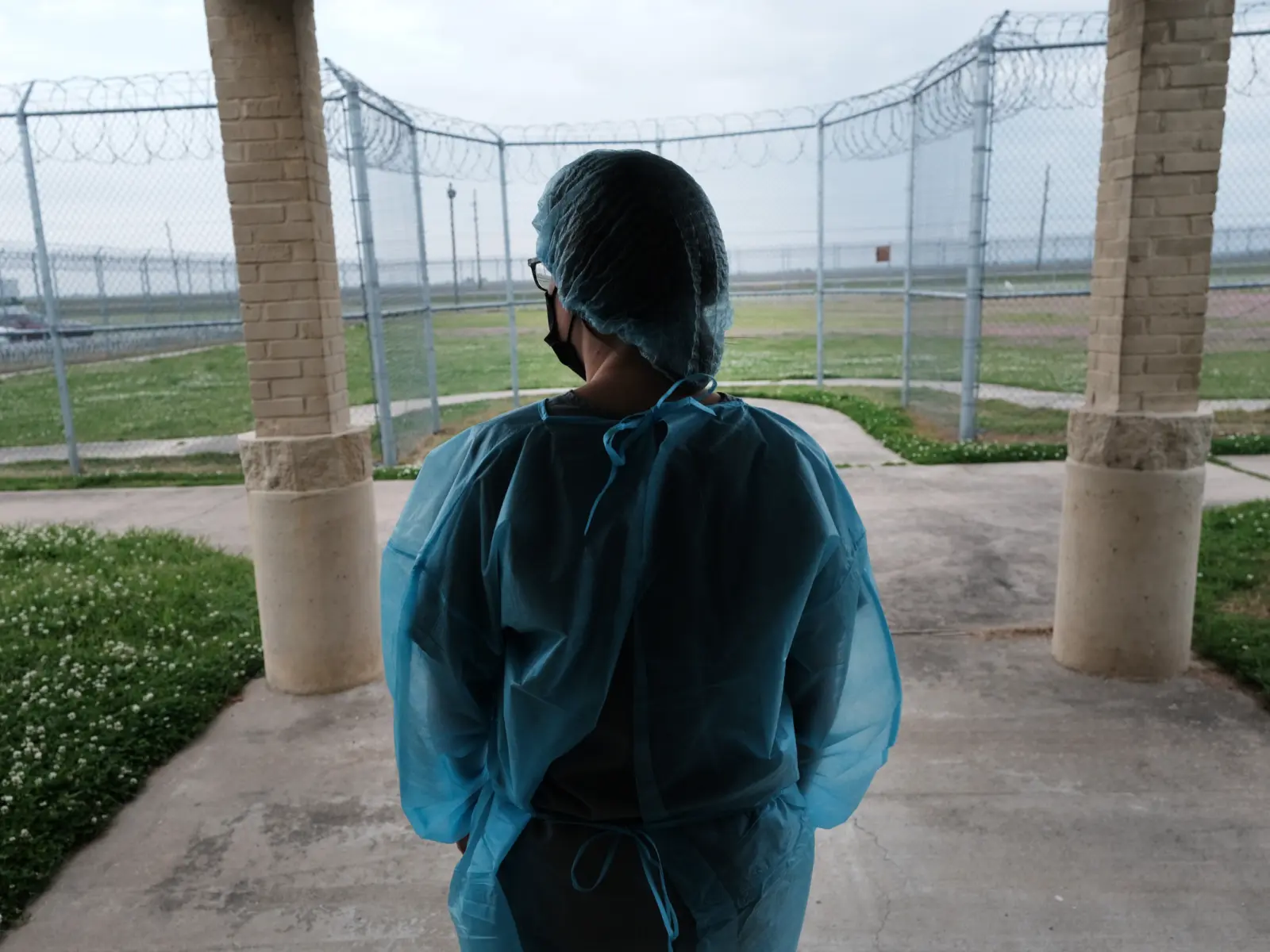In 2021, Dwayne White was sitting in a prison cell at FCI Yazoo City in Mississippi, staring down at least 10 more years on a 25-year sentence. When he was 22, an Illinois judge had handed him a long prison term for a minor role he played in a “stash-house robbery” that turned out to be a law enforcement sting. He had exhausted his appeals early on, and he was missing out on a lot: his daughter’s early years, his brother’s untimely death, his grandfather’s funeral.
“I wasn’t there for any of it,” says White, now 36. “Those are still lumps in my throat that I have to swallow every day.”
One morning, White received a letter from attorney and University of Chicago professor Erica Zunkel, who was researching the now discredited practice of stash-house stings. The First Step Act, a federal law passed in 2018, had drastically expanded possibilities for compassionate release, Zunkel wrote. She and her students were petitioning for White’s freedom.
In April, a judge granted the petition, and White was released to his family in Zion, Illinois, a suburb of Chicago, beginning a long journey of reintegration.
Today, White works as a warehouse operator for a medical supply company while also serving as a community outreach worker for at-risk youth. He recently purchased a home, and he relishes spending time with his 12-year-old daughter. He also takes time out of his days to help his ailing mother around the house. While he was in prison, he thought he might not get to see her again.
“For us to have the time that we have now, it’s hard to describe it,” White says. “It’s a purposeful feeling.”
Now, more people like White will soon be eligible for compassionate release and other forms of sentencing relief. On Nov. 1, a raft of amendments adopted by the United States Sentencing Commission earlier this year were enacted. They provide expanded possibilities for early release, recognizing that a great number of people behind bars pose little to no community safety risk.
Even at a time when issues of community safety feel like they are being politicized again, we can still make progress.Kevin Ring Vice President of Criminal Justice Advocacy at Arnold Ventures
This development represents the most significant change to federal sentencing law since the First Step Act and is being celebrated by experts and advocates on both sides of the political aisle. It promises to address long-standing problems associated with America’s high rate of imprisonment while saving costs and preserving community safety.
“Even at a time when issues of community safety feel like they are being politicized again, we can still make progress,” says Kevin Ring, vice president of criminal justice advocacy at Arnold Ventures. “The truth is that these are just smart policy changes.”
Compelling Reasons for Early Release
The Sentencing Commission is a nonpartisan body of the judicial branch that Congress established in 1984 to define sentencing guidelines for the federal courts. That includes describing the “extraordinary and compelling reasons” that warrant a reduction in a person’s sentence — what is commonly called “compassionate release.” The traditional reasons for compassionate release include serious medical conditions, advanced age, and extreme family circumstances that would require a person’s release to take care of a young child.
The new amendments significantly broaden existing grounds for release. One provides release based on the inability of the Bureau of Prisons to adequately treat a serious medical condition. Another provides for release in the case of public health emergencies, reflecting the lessons learned from the COVID-19 pandemic. There is also an amendment that expands release based on family circumstances to include care for a debilitated parent or an adult child with physical or mental health conditions.
The Sentencing Commission also voted through three new grounds for release. One important amendment provides possibilities for release when a person who is incarcerated survives sexual abuse or physical abuse by prison personnel that results in serious bodily injury.
There has never before been in the policy statement governing compassionate release any opportunity for victims of sexual violence in prisons to ask for a reduced sentence.Mary Price General Counsel at FAMM, formerly Families Against Mandatory Minimums
“There has never before been in the policy statement governing compassionate release any opportunity for victims of sexual violence in prisons to ask for a reduced sentence based on the fact that they survived terrible conduct by the very people paid to protect them,” explains Mary Price, general counsel at FAMM, formerly Families Against Mandatory Minimums, an organization that advocated for the changes.
Another allows reductions of unusually long sentences for people who have served 10 or more years of a sentence that, based on changes to the law, is grossly disparate to the sentence authorized today. Think, for example, of the recent reduction in mandatory minimums for repeat drug convictions that shaved decades off those sentences. Finally, an amendment provides release based on “other reasons,” a category that gives the Bureau of Prisons director and judges discretion to identify unlisted compelling reasons beyond what has been described by the Sentencing Commission.
“Those last three amendments are groundbreaking provisions,” Price says. She notes that litigation about these issues over the last few years influenced the thinking of the commissioners: “The Commission saw the opinions of judges and wanted to account for those decisions as extraordinary and compelling reasons that warrant a second opportunity to look at a case.”
A Bipartisan Effort
The amendments were influenced not only by recent legal outcomes but also by the efforts of advocates across the political spectrum.
Each year, the Sentencing Commission seeks input on what its priorities should be for the next year’s guidelines, soliciting comments from experts in the field. FAMM petitioned for the commissioners to include several provisions — including relief for sexual abuse survivors and those facing unusually long sentences — in its list of priorities. Then, when the Commission sought public comment, the organization helped the agency to assemble a panel of people who had been freed from excessive sentences to provide testimony.
Dwayne White was one of those who stepped up to testify, explaining how his long sentence harmed his chances for rehabilitation — and how compassionate release allowed him to return to society and make positive contributions to his family and community.
Price says testimony from people like White, combined with a receptive environment for change, led to promising outcomes.
“We had terrific commissioners on the Sentencing Commission who were really pulling for change, particularly with regards to unusually long sentences,” she explains. “I think the advocacy around that was important.”
The Conservative Political Action Coalition (CPAC) also provided testimony to the Commission. The organization shared research on the harms of issuing of long sentences for people with no previous criminal history and advocated for retroactive application of sentencing reductions.
Frank Russo, associate general counsel for CPAC’s Nolan Center for Justice, says this measure would protect community safety while also promoting human dignity. Specifically, data shows such people pose little risk to community safety. Keeping them incarcerated stands in the way of their opportunities for rehabilitation.
“They no longer represent a risk to the public, and while they remain in prison, they’re being held back from many of the tools that would allow them to succeed should they be released earlier — things like job training and education that, unfortunately, are not being well facilitated in incarceration settings,” Russo says. “We know now that when they come out, we’re better able to provide those resources, which improve their chances of success and not reoffending.”
Annual cost per inmate in federal prison
Incarcerating such people also comes at great cost. Each federal inmate costs the public roughly $40,000 each year. It’s estimated that thousands of people who are incarcerated could benefit from a reduction, meaning that it could save millions of dollars in public funding.
Budgets are finite, Russo notes, and paying to incarcerate someone who doesn’t need to be there harms them and their families while diverting resources.
“The money could be invested into more effective crime prevention,” Russo says.
The scope of change these amendments represent is a testament to the bipartisan work of advocacy organizations like FAMM and CPAC.
Living Free
Time will tell what impact the amendments have on people’s ability to gain early release when warranted — and what effect that will, in turn, have on their families and communities.
White tells a story that helps him consider the many people who could benefit from sentencing relief. Once, when his young daughter visited him at FCI Yazoo, she saw a line-up of incarcerated men in the yard. “Wow,” she said, “look at all those daddies.” White says that it was a moment of revelation that made him consider how many lives are disrupted by long prison terms, not just in his facility but all across the country.
Since his release, White has advocated compassionate release for others in his position. In addition to testifying before the Sentencing Commission, he has lobbied senators in Washington, D.C., and has spoken to the Tampa Bay Trial Lawyers Association about his case.
Today, he is happy to be home and doing his best to help his family and others seeking release.
“To see the smile that my daughter had, at that airport, the first time she was able to hug me as a free man, to see the smile that my mom had, knowing that she was able to have me back with her,” White says. “It’s definitely fulfilling.”




















